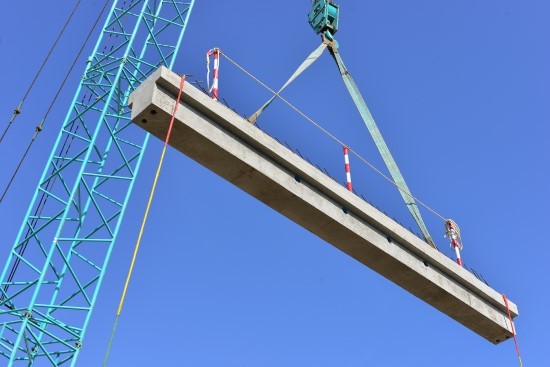Cranes, hoists, and other types of load-bearing lifting machines utilize an array of different rigging to safely and effectively secure, raise, and deposit an endless variety of objects and cargo. Where enormous weights are being transported, there are – as one might imagine – very specific, tried-and-true, items for each job.
Types of Crane/Lift Rigging
Regardless of the type of operation (crane, hoist, winch, etc.), whenever a substantial load is lifted, there will always be two key rigging components required; these would be the fastening hardware, and the sling(s). Basic fasteners include:
Rigging Hooks
Hooks used in rigging are designed to lift heavy objects and eliminate slippage, depending on the materials being moved. Rigging hooks are made of forged alloy steel and chosen based on safe-weight load indication. There are multiple types: sorting, eye, clevis grab, and choker. Hooks are chosen and defined based on “throat,” or the hook’s opening size.
Shackles
Loads exceeding 6,000lbs may require shackles, which are forged with alloy pins and can accommodate loads up to 11,000lbs. Shackles come in anchor, or chain types. Screw pin, round pin, and safety type anchor & chain shackles are available.
Eye Bolts & Steel Nuts
Selection of eye bolts depends on the angle loading – typically 30, 60, or 90 degrees. Eye bolts are commonly used for looping cable or wire and thus must be strong enough to accommodate the required load. Different types of straight and shoulder eye bolts are used in rigging equipment including nut, eye, machinery, and screw, which can vary in size. Nuts are used in conjunction with eye bolts and are made of steel. The dimensions chosen for both eye bolts and nuts are dependent upon the load’s weight, shape, and specifications.
With regards to slings, there are 3 main categories:
Chain Slings
Chain slings are the strongest and most durable type of sling, making them an ideal choice for heavy-duty construction, mining, and manufacturing operations. Usually developed from alloy steel, these slings can withstand extreme conditions in a construction setting and can secure extremely hot loads without getting damaged. The drawbacks of using chain slings are their weight (making them difficult to handle and adding to the overall weight of the load), the potential for scratching and damaging of the cargo, and storage (chain slings are bulky and prone to rusting if stored outside).
Wire Rope Slings
More cost-effective than chain slings, while still providing excellent tensile strength, wire rope slings are a viable alternative for many lifting scenarios. They are produced by weaving individual strands or wires around a core. They are exceptionally strong and resistant to abrasion or cutting. Wire rope slings are available in a range of configurations and dimensions like round braids, flat braids, tri-flex, and cable-laid slings.
Wire rope slings are a popular choice as they come in a wide variety of materials, lays, diameters, and configurations. However, these slings can be susceptible to kinks and twists, so it is always important to inspect them before using. Also, as with chain slings, their narrow profile can damage cargo.
Synthetic Slings
This category is the most versatile type of sling. As the most flexible option, they will easily conform to irregular-shaped loads and are ideal for securing easily damaged loads.
Synthetic Slings
Synthetic slings are a popular choice for riggers due to several advantages:
- Because they are lightweight, these slings are much easier to handle and to deploy – requiring smaller crews and providing savings in labor costs.
- They are easily stored and require little maintenance
- These slings are significantly less expensive than wire rope, or chain slings
- Because of their flexibility and strength, they are very versatile and can be utilized in many applications.
Synthetic slings are lifting slings constructed from man-made fibers – typically polyester and/or nylon. There are two main categories: Endless Round Slings and Synthetic Webbing Slings.
Endless Round Slings
Endless Round Slings are essentially a loop of rope made from thick strands of synthetic (man-made) fibers, such as polyester, and/or nylon. These slings come in a wide variety of lengths (measured from load-bearing point to load-bearing point) and thicknesses.
Synthetic Webbing Slings
Synthetic Webbing Slings are lifting slings constructed from webbing that is woven from man-made fibers – typically polyester and/or nylon.
Like endless round slings these also come in a variety of lengths and widths; however, in addition to the endless (circular) design, web slings come in several flat designs as well. This makes them a potential alternative to wire rope and chain slings – depending on the particular application. Common designs include:
- Eye and Eye – both ends of the slings are sewn into loops. There are several variations of this type.
- Basket Hardware – Steel loops, or triangles are sewn onto the ends of the slings.
- Chocker Hardware Slings – Steel hardware is sewn onto the ends, through which the sling can be fed through and cinched onto a load.
- Bridle Slings – Loops are sewn to sling ends, allowing multiple slings to be joined to a sing lift point.
The key drawback with traditional synthetic webbing slings – those produced from polyester and nylon fibers – is their lower resistance to abrasion and/or cutting. Although these are widely used and very convenient, close attention must be paid to proper use, as well as wear-and-tear. Damaged slings can present a significant hazard to personnel and property.
A 2021 study conducted by Tulsa University engineering professor Dr. Steven Tipton for the Web Sling and Tie Down Association (WSTDA), on the causes of failure of various types of slings, revealed that cutting, resulting from misuse, was the primary culprit among synthetic web slings.
Sentry Lift® High-performance Synthetic Sling Webbing
To address this shortcoming in current synthetic webbing sling designs, OTEX has developed a new, patent-pending, high-performance synthetic webbing for slings. With twice the tensile strength of polyester and/or nylon slings, OTEX’s proprietary Sentry Lift® sling webbing has already exhibited more than 12 times the abrasion resistance, while retaining nearly four times the amount of post-abrasion strength. Early cut test results suggest a similar superiority to traditional materials and designs. This new design breakthrough will lead to much greater safety and savings for the lifting and load-bearing industry.
If you would like to learn more about the Sentry Lift® synthetic sling webbing, or any of our other performance products, please do not hesitate to review our extensive online catalogue. Or, contact our sales department directly. If we do not have an existing product that fits your needs, our Research & Development team will be happy to work with you to come up with a design to meet your exact needs.



